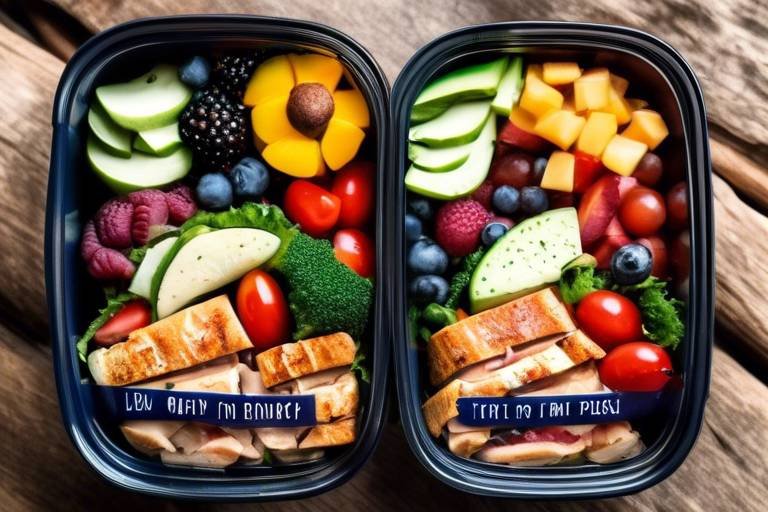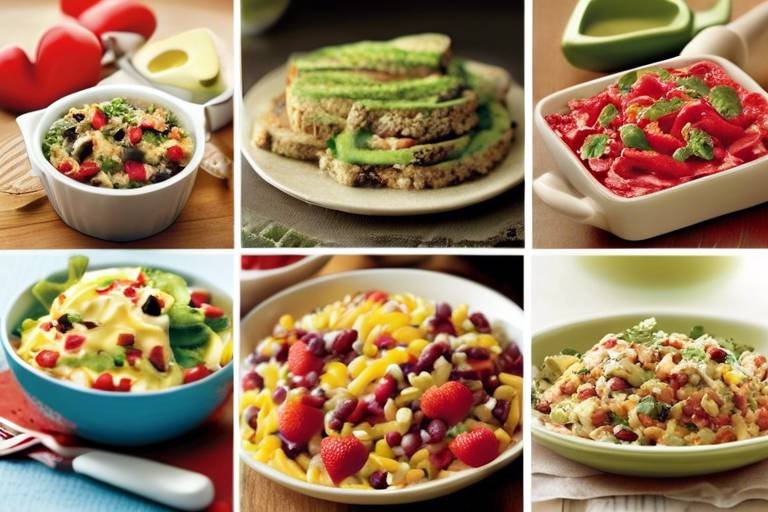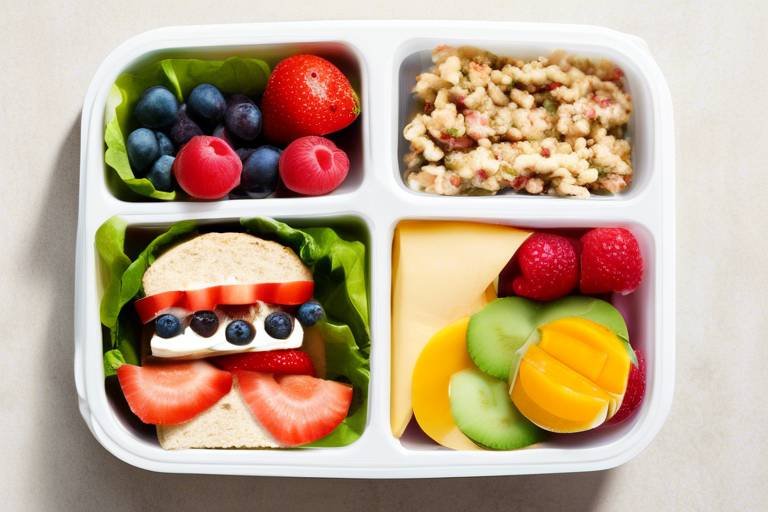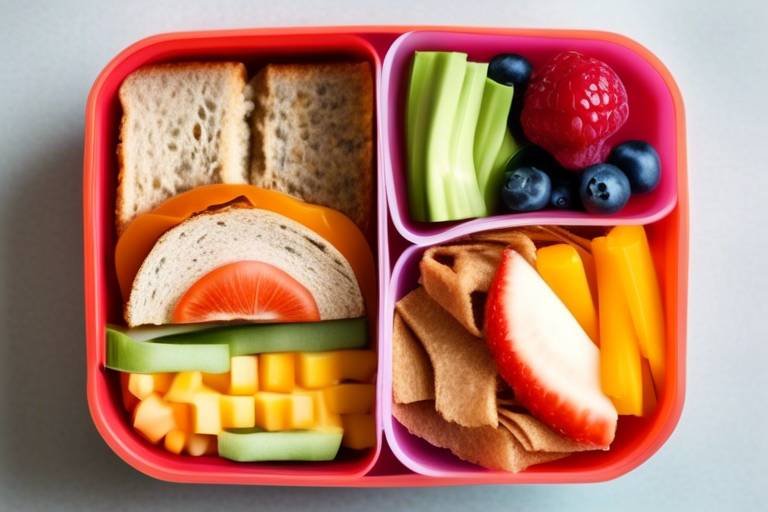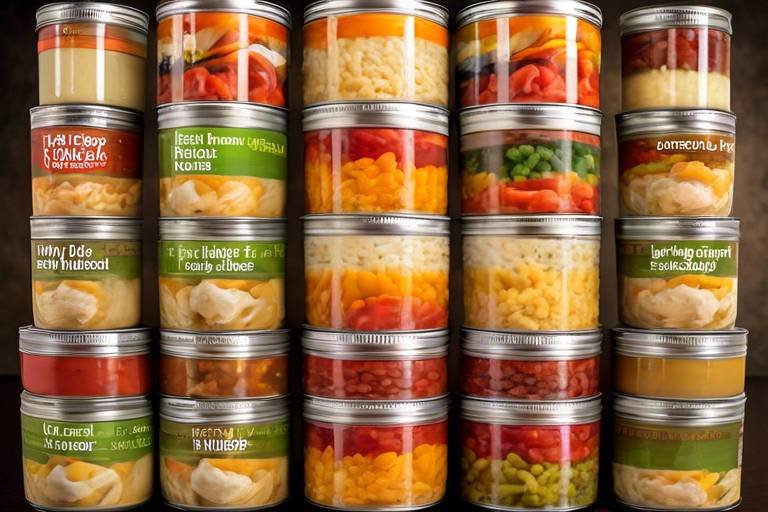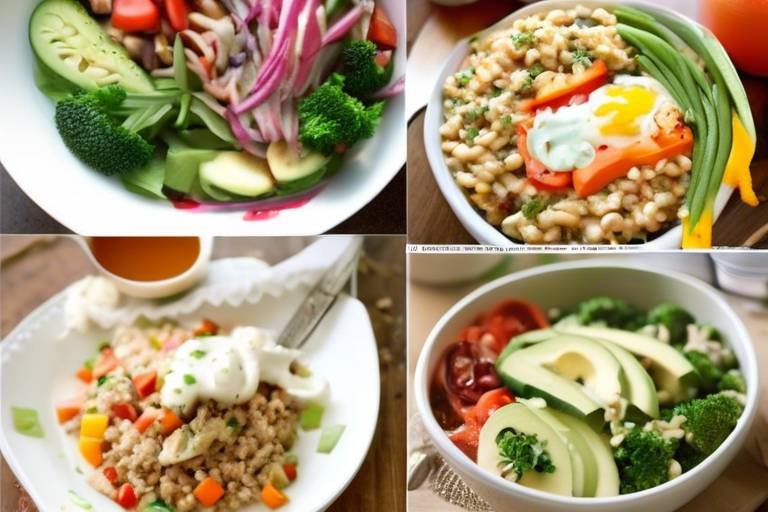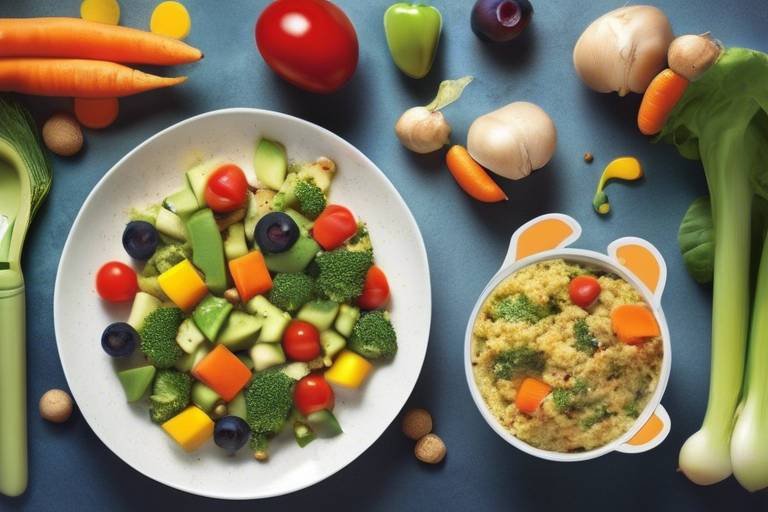10 Budget-Friendly Healthy Meals for Your Family
In today's fast-paced world, feeding your family healthy meals while sticking to a budget can feel like a daunting task. But fear not! With a little creativity and planning, you can whip up delicious, nutritious meals that won't break the bank. The secret lies in choosing ingredients wisely and making the most of what you have. In this article, we will explore ten budget-friendly meal options that are not only affordable but also packed with flavor and nutrients. From breakfast to dinner, these meals will satisfy your family's taste buds and keep your grocery costs in check.
Imagine starting your day with a hearty breakfast that fuels your family for the busy day ahead. How about a wholesome oatmeal bowl topped with fresh fruits and a drizzle of honey? Not only is oatmeal inexpensive, but it’s also a fantastic source of fiber and energy. For lunch, a colorful quinoa salad loaded with veggies can be both filling and refreshing, ensuring your kids have the energy to tackle their afternoon activities. And when it comes to dinner, think of a comforting lentil stew that warms the soul and is easy on the wallet. These are just a few examples of the meals we’ll delve into, each designed to make your life easier while keeping your family's health in mind.
But wait, there's more! We’ll also share tips on meal planning, utilizing leftovers, and incorporating seasonal ingredients, all of which can help you save money and reduce waste. By the end of this article, you'll be equipped with the knowledge and inspiration to create a week’s worth of healthy meals that your family will love. So, let’s dive in and discover how you can make budget-friendly cooking both fun and satisfying!

Meal Planning Basics
Meal planning is like having a secret weapon in your kitchen arsenal. It’s not just about deciding what to eat; it’s about strategically organizing your meals to save both time and money. Imagine walking into your kitchen knowing exactly what ingredients you need, how long each meal will take to prepare, and avoiding those last-minute takeout calls that can drain your wallet. Sounds great, right?
One of the biggest advantages of meal planning is that it allows you to make healthier choices. When you plan your meals ahead of time, you can focus on incorporating more nutritious ingredients into your diet. Instead of grabbing fast food because you’re too tired to cook, you’ll have a delicious, healthy meal ready to go. Plus, it helps you avoid impulse buying at the grocery store, which can often lead to purchasing items that aren’t good for your health or your budget.
So, how do you get started with meal planning? First, assess your family’s schedule. Are there days when everyone is home for dinner, or are there nights when you’re running from one activity to another? Knowing your family’s routine can help you decide which meals to prepare in advance and which ones can be quick and easy. Next, take a look at what you already have in your pantry and fridge. This way, you can create meals around those ingredients, reducing waste and saving money.
When creating your weekly menu, consider the following tips:
- Balance Your Meals: Aim for a mix of proteins, grains, and vegetables. This not only keeps meals interesting but also ensures that everyone gets the nutrients they need.
- Incorporate Leftovers: Plan meals that can be repurposed into new dishes. For example, grilled chicken can be used in salads, sandwiches, or stir-fries.
- Be Flexible: Life happens! Don’t stress if you need to swap meals around. Just keep it simple and adjust your plan as necessary.
Additionally, creating a shopping list based on your meal plan can help you stay organized and focused while grocery shopping. Stick to the list to avoid unnecessary purchases. You might even want to set a budget for your grocery shopping. This will encourage you to look for sales and discounts, allowing you to stretch your dollars further.
Lastly, remember to keep it fun! Involve your family in the meal planning process. Ask them what they’d like to eat and let them help with the cooking. This not only makes them more excited about mealtime but also teaches them valuable skills in the kitchen. Meal planning doesn't have to be a chore; it can be a delightful family activity that brings everyone together.

Breakfast Ideas
Starting the day off right is crucial, and what better way to do that than with a nutritious breakfast that doesn't drain your wallet? Breakfast is often dubbed the most important meal of the day, and for good reason! It fuels your body and mind, setting the tone for the hours ahead. So, let’s dive into some budget-friendly breakfast ideas that are not only healthy but also quick and easy to whip up. No need for fancy ingredients or complicated recipes; just wholesome goodness that your family will love!
First up, we have the classic oatmeal. Oats are a powerhouse of nutrition and incredibly versatile. You can prepare them in various ways, from overnight oats to a warm bowl topped with fruits and nuts. Just imagine waking up to a cozy bowl of oatmeal, topped with a drizzle of honey and fresh berries. Not only is it filling, but it’s also a fantastic way to kickstart your day with energy. Plus, oats are super affordable, making them a staple in many households.
Another fantastic option is smoothies. These are perfect for busy mornings when you’re on the go. Just blend up some frozen fruits, yogurt, and a splash of milk or juice, and you’re good to go! You can even sneak in some spinach or kale for an extra nutrient boost without compromising on taste. Smoothies are not only quick to prepare but also a fun way to get your kids involved in breakfast prep. Let them choose their favorite fruits, and watch as they enjoy their colorful creations!
For those who love a savory start, egg dishes are a winner. Eggs are packed with protein and can be cooked in countless ways. Try making a simple vegetable omelet or scrambled eggs with a side of whole-grain toast. You can even make a big batch of egg muffins on the weekend and pop them in the fridge for a quick grab-and-go breakfast during the week. The possibilities are endless, and they are sure to keep everyone satisfied until lunch.
Let’s not forget about yogurt parfaits. Layer some yogurt with granola and fresh fruits for a deliciously satisfying breakfast. Not only does it look appealing, but it’s also a great way to get a mix of textures and flavors. You can prepare these the night before in jars, making mornings a breeze. Just grab and go! Plus, buying yogurt in bulk can save you a few bucks, and you can choose low-fat or Greek options for added protein.
Lastly, consider incorporating whole grain pancakes into your breakfast rotation. You can make a big batch and freeze them for later. Just pop them in the toaster when you’re ready to eat! Top with some peanut butter and banana for a delicious, filling breakfast that will keep everyone happy. Making pancakes from scratch is easy, and it’s a fun way to get the kids involved in cooking!
To sum it all up, breakfast doesn’t have to be boring or expensive. With a little creativity, you can whip up a variety of meals that are both nutritious and budget-friendly. So, whether you’re in the mood for something sweet like oatmeal or pancakes, or something savory like eggs or a smoothie, there’s always an option that will please the whole family. Now, let’s move on to some delicious lunch options that will keep the momentum going throughout the day!
1. What are some quick breakfast ideas for busy mornings?
Some quick breakfast ideas include smoothies, overnight oats, or yogurt parfaits. These can be prepared in advance and are easy to grab on the go!
2. How can I make breakfast healthier?
Incorporate more whole grains, fruits, and vegetables into your breakfast. Opt for natural sweeteners instead of sugar and choose lean proteins like eggs or Greek yogurt.
3. Are there budget-friendly options for breakfast?
Absolutely! Oats, eggs, and seasonal fruits are all affordable options. Buying in bulk and planning meals can also help save money.
4. How can I get my kids to eat healthier breakfasts?
Involve them in the cooking process! Let them choose their favorite fruits for smoothies or help make pancakes. Making breakfast fun can encourage them to try new things.

Lunch Options
When it comes to for your family, you want meals that are not only delicious but also nutritious and budget-friendly. After all, a great lunch can provide the energy boost needed to power through the rest of the day. So, how do you strike that perfect balance? Let’s dive into some fantastic ideas that will keep your family satisfied without emptying your wallet.
One of the best ways to ensure healthy lunches is by incorporating whole grains and lean proteins into your meals. Think about options like quinoa salad or chickpea wraps. These meals are not only filling but also packed with essential nutrients. For instance, a quinoa salad can be made with seasonal vegetables, a drizzle of olive oil, and a sprinkle of lemon juice. It’s a refreshing choice that’s both colorful and appetizing!
Another great idea is to prepare vegetable stir-fries. They are incredibly versatile and can be made with whatever veggies you have on hand. Just sauté some bell peppers, broccoli, and carrots in a bit of sesame oil, toss in some cooked brown rice, and add a splash of soy sauce. Voila! You have a delightful lunch that’s quick to prepare and loaded with vitamins.
If you’re looking for something that can be prepped in advance, consider making homemade soups. Not only are they comforting, but they can also be made in large batches and frozen for later use. For example, a hearty lentil soup can be made with just a few ingredients like lentils, diced tomatoes, and spinach. This way, you can serve a warm, nutritious meal even on the busiest of days.
Don’t forget about the classic sandwich or wrap options! Using whole grain bread or tortillas can elevate a simple lunch into something more substantial. Fill them with lean turkey, hummus, and plenty of veggies. The beauty of these meals is their simplicity and the fact that they can be customized to suit everyone’s taste. You could even create a fun DIY sandwich bar where each family member can build their own masterpiece!
For a quick and easy lunch that’s also a crowd-pleaser, try pasta salads. Cook up some whole grain pasta, toss it with cherry tomatoes, olives, feta cheese, and a drizzle of balsamic vinaigrette. This dish can be served cold and is perfect for those warm days when a hot meal doesn’t sound appealing. Plus, it can be made in advance and stored in the fridge, making it a convenient option for busy weekdays.
Finally, let’s not forget about snack boxes. These are not only fun to prepare but also allow for a variety of healthy options. You can fill them with sliced fruits, veggies, cheese, and whole grain crackers. It’s like a mini buffet that keeps lunchtime exciting and encourages your family to eat a range of healthy foods.
In conclusion, lunch doesn’t have to be boring or expensive. With a little creativity and planning, you can put together meals that are both delicious and nutritious. So, grab your apron and get ready to whip up some budget-friendly lunches that your family will love!
- What are some quick lunch ideas for busy weekdays?
Consider making wraps, salads, or pasta dishes that can be prepared in advance. These options are not only quick but also healthy! - How can I make sure my kids eat their lunches?
Get them involved in the lunch preparation process. Allowing them to choose their ingredients can make them more excited about eating what they’ve made. - Are there any budget-friendly lunch options for picky eaters?
Try to include a variety of textures and flavors. Homemade pizzas or quesadillas can be a hit since they can be customized to each person’s taste.

Dinner Recipes
When it comes to dinner, finding recipes that are both nutritious and budget-friendly can feel like a daunting task. But fear not! With a little creativity and some simple ingredients, you can whip up meals that not only satisfy your family's hunger but also keep your wallet happy. Imagine serving a hearty dinner that feels like a feast without the hefty price tag—sounds dreamy, right?
One of the best ways to ensure dinner is both healthy and affordable is to focus on whole foods that are easy to prepare. For instance, consider a classic vegetable stir-fry. You can use whatever vegetables are in season or on sale, toss them in a hot pan with a splash of soy sauce, and serve them over rice or quinoa. This dish is not only colorful and appealing but also packed with nutrients. Plus, it can be made in under 30 minutes, making it perfect for busy weeknights.
Another fantastic option is a chicken and bean chili. This dish is a powerhouse of protein and fiber, and it’s incredibly filling. You can prepare it in a large pot and let it simmer while you tackle other chores around the house. Here’s a quick breakdown of how to make it:
| Ingredients | Quantity |
|---|---|
| Ground chicken (or turkey) | 1 lb |
| Canned beans (black, kidney, or pinto) | 2 cans |
| Diced tomatoes | 1 can |
| Chili powder | 2 tbsp |
| Onion | 1, chopped |
| Bell peppers | 1-2, chopped |
Simply brown the ground chicken in a pot, add the onions and peppers, and sauté until soft. Then, stir in the beans, tomatoes, and chili powder, and let it simmer for about 20 minutes. Serve it with a side of whole-grain bread or over a bed of rice for a complete meal. This dish is not only delicious but also a great way to use up any leftover veggies you have in your fridge!
If you're looking to spice things up, consider a vegetarian curry. Using ingredients like lentils, coconut milk, and a mix of your favorite spices, you can create a warm, comforting dish that is both filling and nutritious. Serve it with brown rice or whole grain naan for a wholesome family dinner. The beauty of curry is that it allows for endless variations, so feel free to experiment with different vegetables and spices based on what you have on hand.
Lastly, don’t underestimate the power of a good old-fashioned pasta dish. Whole wheat pasta tossed with sautéed garlic, seasonal vegetables, and a splash of olive oil can be a delightful dinner option. Add some grilled chicken or chickpeas for extra protein, and you have yourself a meal that’s both satisfying and easy on the budget.
In conclusion, dinner doesn’t have to be complicated or expensive. With a little planning and creativity, you can prepare meals that your family will love while keeping your finances in check. Remember, the key is to use fresh, seasonal ingredients and to embrace the versatility of simple recipes. Happy cooking!
Q: How can I make my meals healthier without spending more?
A: Focus on whole foods, seasonal produce, and cooking from scratch. Simple ingredients like grains, legumes, and fresh vegetables are often cheaper and healthier than processed options.
Q: What are some quick dinner ideas for busy nights?
A: Consider stir-fries, pasta dishes, or one-pot meals like chili or curry. These can be prepared in under 30 minutes and often use minimal ingredients.
Q: How can I use leftovers creatively?
A: Repurpose leftovers into new meals, such as turning roasted chicken into chicken salad or using extra veggies in a frittata. This not only saves money but also reduces food waste!

Snacks on a Budget
When it comes to keeping your family satisfied between meals, snacking can often feel like a budget buster. But fear not! You can whip up healthy snacks that won't drain your wallet. Imagine a world where your kids can munch happily without you worrying about the cost. Sounds great, right? Let’s dive into some delicious and affordable snack ideas that are easy to prepare and will keep your family coming back for more!
First off, consider the power of fruits and vegetables. These are not only nutritious but also incredibly versatile. You can buy seasonal produce in bulk, which is often cheaper, and use it in various ways. For instance, a simple fruit salad can be made with apples, bananas, and oranges. Just chop them up, mix them together, and voilà! You have a refreshing snack that’s bursting with vitamins. Additionally, you can make veggie sticks with carrots, cucumbers, and bell peppers. Pair them with a homemade hummus for a delightful crunch that’s both healthy and filling.
If you’re looking for something a bit more substantial, consider making homemade popcorn. It’s an incredibly budget-friendly snack that’s perfect for movie nights or afternoon munchies. All you need is some popcorn kernels and a pot. Popcorn is a whole grain and can be seasoned with various spices to keep things interesting. Try adding a sprinkle of nutritional yeast for a cheesy flavor without the calories of cheese!
Another fantastic option is to prepare energy balls. These little bites are packed with nutrients and can be customized to your taste. Combine oats, nut butter, honey, and your choice of add-ins like chocolate chips, dried fruit, or seeds. Roll them into balls and refrigerate. Not only are they easy to make, but they also provide a quick energy boost for active kids. Plus, they’re great for on-the-go snacking!
Let’s not forget about yogurt. Buying a large tub of plain yogurt is often cheaper than individual cups. You can sweeten it naturally with honey or maple syrup and add fruits or granola for a tasty treat. This way, you’re not only saving money, but you’re also avoiding the added sugars found in many store-bought yogurts.
For those days when you have a bit of time to spare, consider baking your own granola bars. They’re surprisingly simple to make and can be tailored to your family’s preferences. Mix oats, honey, nut butter, and any additional ingredients like nuts or chocolate chips. Spread the mixture in a pan, bake, and cut into bars. This way, you’ll have a healthy snack ready for the week!
Lastly, if you find yourself with leftover bread, don’t toss it! Instead, turn it into croutons or breadsticks. Just cut the bread into cubes, toss with olive oil and your favorite seasonings, and bake until crispy. These can be perfect for snacking or even adding crunch to salads.
In conclusion, snacking doesn’t have to be expensive or unhealthy. With a little creativity and planning, you can provide your family with nutritious snacks that are easy on the wallet. So next time you’re at the grocery store, think outside the box and stock up on these budget-friendly options. Your family will thank you, and your bank account will too!
Q: What are some other budget-friendly snacks I can make at home?
A: Other options include homemade trail mix, baked sweet potato fries, or even simple cheese and whole-grain crackers.
Q: How can I encourage my kids to eat healthier snacks?
A: Get them involved in the snack-making process! Let them choose ingredients and help prepare the snacks. This way, they’re more likely to enjoy what they eat.
Q: Are there any snacks I should avoid when on a budget?
A: Try to avoid pre-packaged snacks that are often more expensive and less healthy. Instead, focus on whole foods and ingredients you can use to create your own snacks.

Utilizing Leftovers
When it comes to managing a household on a budget, one of the best strategies is to make the most of your leftovers. Instead of letting those extra servings languish in the fridge, why not transform them into something new and exciting? This not only helps reduce food waste but also stretches your grocery budget further. Think of leftovers as a blank canvas; with a little creativity, you can whip up delicious meals that your family will love!
For instance, leftover roasted chicken can easily be turned into a hearty chicken salad or a comforting soup. Simply shred the chicken and toss it with some greens, nuts, and a light dressing for a refreshing salad. Alternatively, simmer it with some broth, vegetables, and spices to create a warm, nourishing soup that can feed the family on a chilly evening. The possibilities are endless!
Another fantastic way to utilize leftovers is by incorporating them into casseroles. If you have leftover rice or pasta, combine them with some vegetables, a protein source, and a creamy sauce, then bake it all together for a delightful one-dish meal. This method not only saves time but also ensures that nothing goes to waste.
Here’s a quick overview of some common leftovers and potential transformations:
| Leftover | Transformation |
|---|---|
| Roasted Vegetables | Veggie Stir-fry or Frittata |
| Cooked Grains (Rice, Quinoa) | Grain Bowls or Stuffed Peppers |
| Grilled Meat | Tacos or Sandwiches |
| Pasta | Pasta Bake or Salad |
Don't forget about breakfast! Leftover pancakes or waffles can be frozen and reheated for a quick morning meal. You can even blend them into a smoothie for a fun twist!
Lastly, consider implementing a “leftover night” into your weekly meal plan. This is a designated evening where you clear out the fridge and enjoy whatever leftovers you have. It’s a fun way to experiment with flavors and combinations while ensuring nothing goes to waste. Plus, it can become a family tradition that everyone looks forward to!
In summary, utilizing leftovers is not just a smart financial choice; it’s also an opportunity to get creative in the kitchen. By thinking outside the box and repurposing what you already have, you can provide your family with nutritious meals without the extra expense. So next time you find yourself with extra food, remember that it doesn't have to be the end—it can be the beginning of something delicious!
Q: How long can I keep leftovers in the fridge?
A: Typically, leftovers can be safely stored in the refrigerator for about 3 to 4 days. Always check for signs of spoilage before consuming.
Q: Can I freeze leftovers?
A: Yes! Most leftovers can be frozen for up to 3 months. Just make sure to store them in airtight containers to prevent freezer burn.
Q: What are some easy ways to use up leftover vegetables?
A: Leftover vegetables can be added to soups, stir-fries, omelets, or blended into smoothies. They can also be tossed into salads or made into veggie patties.

Seasonal Ingredients
When it comes to preparing budget-friendly meals for your family, one of the best strategies is to focus on . Why, you ask? Well, seasonal produce is not only fresher and more flavorful, but it also tends to be significantly cheaper than out-of-season options. Imagine biting into a ripe, juicy tomato in the summer, bursting with flavor, versus a bland, mealy one in winter. Seasonal ingredients can transform your meals from mundane to magnificent!
Utilizing seasonal produce allows you to embrace the natural rhythm of the year. Each season brings its own bounty, which can inspire your cooking and keep your family excited about meals. For instance, in the spring, you might enjoy asparagus and peas, while fall brings hearty squash and sweet potatoes. By incorporating these ingredients into your weekly menu, you not only save money but also ensure your family is getting the freshest and most nutritious options available.
Here’s a quick overview of some seasonal ingredients you can look forward to throughout the year:
| Season | Fruits | Vegetables |
|---|---|---|
| Spring | Strawberries, Cherries | Asparagus, Spinach, Radishes |
| Summer | Peaches, Watermelon | Tomatoes, Zucchini, Corn |
| Fall | Apples, Pears | Squash, Brussels Sprouts, Carrots |
| Winter | Citrus Fruits, Pomegranates | Kale, Cabbage, Root Vegetables |
Incorporating these seasonal ingredients into your meals can be as simple as planning your grocery list around what's currently available. Not only will this help you stick to your budget, but it also encourages variety in your family's diet. You might even find that your kids are more willing to try new foods when they’re at their peak freshness!
Additionally, shopping at local farmers' markets can be a delightful experience. You get to support local farmers and often find produce that’s fresher than what’s available in grocery stores. Plus, you can ask the vendors for tips on how to prepare their seasonal offerings, which can inspire new meal ideas and cooking techniques.
So, next time you're planning your meals, take a moment to consider what's in season. Embrace the flavors of the season, and watch as your meals become not only healthier but also more enjoyable for the whole family. After all, eating seasonally is not just a trend; it’s a lifestyle that promotes sustainability and supports local economies while keeping your family’s health in check.
Q: What are the benefits of eating seasonal ingredients?
A: Eating seasonal ingredients can lead to fresher, more flavorful meals, lower grocery costs, and a more varied diet. It also supports local farmers and reduces environmental impact.
Q: How do I find out what’s in season?
A: You can check local farmers' market schedules, consult seasonal produce guides online, or visit your grocery store to see what’s prominently displayed for the season.
Q: Are seasonal ingredients always cheaper?
A: Generally, yes! Seasonal ingredients are often in greater supply, which drives prices down. However, prices can vary based on location and availability, so it's good to shop around.

Cooking in Bulk
When it comes to providing nutritious meals for your family while keeping an eye on the budget, is a game changer. Imagine opening your fridge to find a treasure trove of ready-made meals, each one bursting with flavor and packed with healthy ingredients. Not only does this method save time, but it also helps you avoid the temptation of ordering takeout on those busy weeknights. But how do you get started with bulk cooking? Let's dive in!
First and foremost, planning is key. Before you even think about pulling out your pots and pans, take a moment to sketch out a meal plan for the week. This will not only give you a clear idea of what you need to buy but will also help you avoid impulse purchases at the grocery store. Aim to choose recipes that share ingredients to minimize waste and maximize savings. For instance, if you're making chili, you can use the same bell peppers in a stir-fry later in the week. Talk about efficiency!
Next, gather your ingredients and start cooking. A great tip is to dedicate a day, perhaps Sunday, to batch cooking. Prepare large portions of meals that can be easily stored and reheated. Some fantastic options include:
- Soups and Stews: These are perfect for bulk cooking as they often taste even better the next day and can be frozen for later.
- Casseroles: A hearty casserole can feed a crowd and is easy to portion out for the week.
- Grains: Cook a large batch of rice, quinoa, or pasta to use in various meals throughout the week.
Once you've cooked your meals, it's essential to store them properly. Invest in some good-quality, airtight containers, and label each one with the date and contents. This way, you can easily grab a meal when you're short on time. A well-organized fridge is a happy fridge!
Additionally, consider the benefits of freezing meals. Not only does this extend the shelf life of your food, but it also allows you to have a variety of meals ready to go. Just remember to leave some space in your containers for expansion as food freezes. You wouldn’t want a surprise explosion of spaghetti sauce in your freezer, would you?
Cooking in bulk also opens the door to creativity. If you find yourself with leftovers, think outside the box! For example, leftover roasted vegetables can be tossed into an omelet or blended into a creamy soup. This not only reduces food waste but also keeps your meals exciting and varied.
Lastly, don’t forget the social aspect of cooking in bulk. Invite friends or family over for a cooking session. Not only will you save time, but you’ll also have fun while preparing meals. You can exchange recipes, share cooking tips, and maybe even create a new family tradition.
In conclusion, cooking in bulk is not just about saving money; it’s about creating a lifestyle that prioritizes health, convenience, and family time. So, roll up your sleeves, put on your apron, and get ready to make meal prep a breeze!
1. How long can I store bulk meals in the freezer?
Most meals can be safely stored in the freezer for up to three months. Just make sure to label them with the date!
2. Can I cook any meal in bulk?
While many meals are suitable for bulk cooking, dishes that freeze well include soups, stews, casseroles, and grain-based dishes. Avoid meals with high water content, like salads, as they may not freeze well.
3. How do I reheat frozen meals?
You can reheat frozen meals in the microwave, oven, or stovetop. Just make sure they are heated thoroughly to an internal temperature of 165°F (74°C).
Frequently Asked Questions
-
What are some budget-friendly meal planning tips?
Meal planning is all about strategy! Start by creating a weekly menu based on what you already have at home. This helps avoid unnecessary purchases. Make a shopping list focusing on seasonal produce and sales to maximize your savings. Consider cooking in bulk and using leftovers creatively to stretch your budget even further.
-
Can you provide examples of healthy breakfast options?
Absolutely! Some great budget-friendly breakfast ideas include oatmeal topped with fruits, scrambled eggs with veggies, and smoothies made from frozen fruits and spinach. These meals are not only nutritious but also quick to prepare, ensuring your family starts the day with energy!
-
What are some affordable lunch ideas for kids?
Lunch doesn't have to be boring or expensive! Try making whole grain wraps filled with hummus and veggies, quinoa salads with beans, or simple pasta salads. These options are not only delicious but also easy to pack for school or work!
-
How can I make healthy dinners on a budget?
For dinner, think simple! Meals like stir-fried vegetables with rice, bean chili, or baked chicken with seasonal veggies are budget-friendly and packed with nutrients. Using fewer ingredients doesn't mean skimping on flavor—spices can work wonders!
-
What are some healthy snack options that won’t break the bank?
Snacking can be healthy and affordable! Consider making popcorn, yogurt with fruit, or homemade trail mix with nuts and seeds. These snacks are not only filling but also provide the energy your family needs throughout the day.
-
How can I repurpose leftovers creatively?
Leftovers can be a lifesaver! Transform last night's roasted veggies into a hearty soup or use leftover chicken in a salad or wrap. Get creative—think of your leftovers as the foundation for a new meal rather than just reheating them!
-
Why should I use seasonal ingredients?
Seasonal produce is not only fresher but also cheaper! When you buy fruits and vegetables that are in season, you get better flavor and quality while saving money. Plus, it’s a fun way to experiment with new recipes as the seasons change!
-
What are the benefits of cooking in bulk?
Cooking in bulk is a game-changer! It saves time, reduces stress during busy weekdays, and allows you to control ingredients, ensuring your family eats healthy. Plus, you can freeze portions for later, which makes meal prep a breeze!


